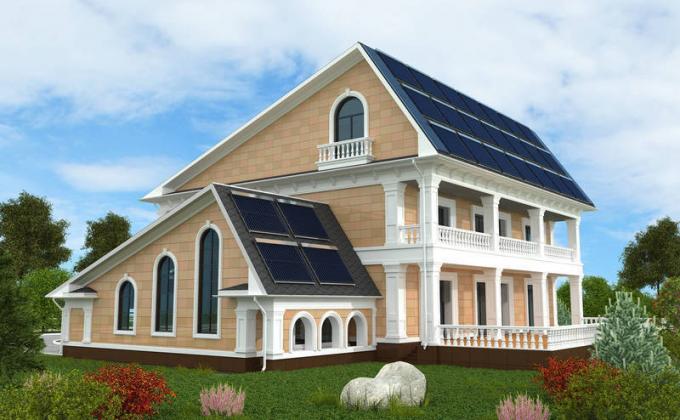
Passive house (translated from German “Passivhaus”) is a building with minimal energy consumption, a building without heating, which is an independent isolated power system.
The specifics of a passive house
At the same time, hot water supply, ventilation, cooling and heating systems of passive housing are provided through alternative energy (geothermal sources, wind energy, solar heat, cold and earth heat, etc.) thanks to renewable energy installations: ground heat exchangers, solar collectors, thermal power plants, heat pumps and other things.
On average, in a passive house, energy costs for heating are no more than 15 kW • h / y per 1 sq. M. buildings (while in energy-saving houses this figure is 75 kW • h / a). This requirement is dictated by the creators of the innovative development - the Passive House Institute, which is located in the city of Darmstadt.
It is noteworthy that the described prescription is relevant for all passive houses on the planet. That is why, in modern conditions, a passive house is considered the most strictly controlled, clearly coordinated new form of construction.
Due to its exceptional construction idea, passive housing can eliminate the need to choose a chimney, storage for combustible materials, heating appliances, piping systems, and a gas boiler. Exclusively in case of severe frosts, additional heating may be required for such a house by means of, for example, a heat pump system.
On average, passive housing protects the natural environment from 4 thousand kilograms of toxic carbon dioxide emissions per year. Buildings of this kind for heating consume 80% less energy than an ordinary house, and also 4, 7 times less than energy-efficient buildings. And yet, in order for the passive house to function correctly, it is important to adhere to these rules:
passive use of solar energy through a large area of southern windows with special frames, double glazing. Essentially, in passive housing, the building itself acts as a solar collector;
supply and exhaust ventilation guarantees about 90% of thermal recuperation. Recuperation is understood as the previous heating of fresh air due to the heat of the exhaust air stored in the heat exchanger;
due to impermeable joints, the possibility of uncontrolled air exchange is excluded. As a result, deterioration in the quality of air supply, the appearance of mold, loss of heat is absolutely excluded;
cold bridges are not observed. In particular, this applies to the following places: areas of abutment of balconies to the wall, box for blinds, window lintels, etc.
excellent insulation. As a rule, in the process of building energy-efficient housing, it is customary to use 8-12 centimeters of a heat-insulating ball. As for the passive house, this standard is from 22 to 30 centimeters.
In addition to significant savings in heating costs, as well as a dramatic reduction in the volume of toxic emissions, the aspect of health itself is considered to be an important advantage of an eco-house. So, for the passive application of solar energy, large windows are needed, placed in the south direction. In general, the southern facades of such buildings have panoramic balconies or panoramic windows.
Enhanced daylight provision is characterized by the following medical effects:
no dust, no allergic reactions - the air sucked in from the outside is pre-filtered. A significant proportion of pollution, dust, odors, excess moisture in the house is gradually pumped out, taken out;
heat losses of the passive building are minimized. In order to reduce heat loss through the ventilation system, an extremely efficient ventilation system is installed in the eco-house, thanks to which all living quarters are supplied with clean, fresh air. In accordance with sanitary standards, in order to maintain the normal state of health of one tenant, 30 cubic meters of fresh oxygen per hour are needed. This value is significantly reduced in the case of ventilation in the cold periods of the year. Moreover, according to the results of numerous studies, it became clear that buildings with an automatic ventilation system (controlled) have a higher air quality, since the required volume of pure oxygen is regularly supplied to the premises of the house, and this, for example, cannot be corrected by ordinary ventilation;
under the influence of sunlight in the human body, vitamin D is produced in the required amount;
due to sunlight, the body produces serotonin - the hormone of happiness, mood, which prevents the development of depressive conditions in the winter.
